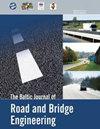Potential of MSWI bottom ash to be used as aggregate in road building materials
IF 1.1
4区 工程技术
Q4 ENGINEERING, CIVIL
引用次数: 18
Abstract
In the European Union, more than 140 million tonnes of municipal solid waste is incinerated annually. It generates about 30–40 million tonnes of residues known as municipal solid waste incinerator bottom ash, which is typically landfilled. To deal with growing landfills, there is a need to utilize municipal solid waste incinerator bottom ash as a building material. It has been known that municipal solid waste incinerator bottom ash properties strongly depend on waste composition, which is directly influenced by people’s habits, economic policy, and technologies for metals recovery of bottom ash. Thus, municipal solid waste incinerator bottom ash produced in a specific country or region has primarily to be tested to determine its physical and mechanical properties. The main aim of this study is to determine municipal solid waste incinerator bottom ash physical and mechanical properties (aggregate particle size distribution, water content, oven-dried particle density, loose bulk density, Proctor density, optimal water content, California Bearing Ratio after and before soaking, permeability, Flakiness Index, Shape Index, percentage of crushed and broken surfaces, resistance to fragmentation (Los Angeles coefficient), water absorption and resistance to freezing and thawing). Municipal solid waste in-cinerator bottom ash produced in the waste-to-energy plant in Klaipėda (Lithuania) was used in this research. Ferrous and non-ferrous metals were separated after more than three months of municipal solid waste incinerator bottom ash ageing in the atmosphere. The study showed promising results from considering municipal solid waste incinerator bottom ash as possible aggregates for road building materials.城市生活垃圾底灰作为公路建筑材料集料的潜力
在欧盟,每年焚烧的城市固体废物超过1.4亿吨。它产生了约3000万至4000万吨被称为城市固体废物焚烧炉底灰的残留物,这些残留物通常被填埋。为了处理日益增长的垃圾填埋场,需要利用城市固体废物焚烧炉底灰作为建筑材料。众所周知,城市固体废物焚烧炉底灰的性质在很大程度上取决于废物的组成,这直接受到人们的生活习惯、经济政策和底灰金属回收技术的影响。因此,在特定国家或地区生产的城市固体废物焚烧炉底灰必须首先进行测试,以确定其物理和机械性能。本研究的主要目的是确定城市固体废物焚烧炉底灰的物理力学性能(骨料粒度分布、含水量、烘干颗粒密度、松散堆积密度、普氏密度、最佳含水量、浸泡后和浸泡前的加州承载比、渗透性、薄片指数、形状指数、压碎和破碎表面的百分比、抗碎裂性(洛杉矶系数)、吸水性和抗冻融性)。本研究使用了Klaipëda(立陶宛)垃圾焚烧发电厂产生的城市固体废物,即焚烧炉底灰。经过三个多月的城市固体废物焚烧炉底灰在大气中老化,黑色金属和有色金属被分离。该研究表明,考虑将城市固体废物焚烧炉底灰作为道路建筑材料的可能骨料,结果很有希望。
本文章由计算机程序翻译,如有差异,请以英文原文为准。
求助全文
约1分钟内获得全文
求助全文
来源期刊
CiteScore
2.10
自引率
9.10%
发文量
25
审稿时长
>12 weeks
期刊介绍:
THE JOURNAL IS DESIGNED FOR PUBLISHING PAPERS CONCERNING THE FOLLOWING AREAS OF RESEARCH:
road and bridge research and design,
road construction materials and technologies,
bridge construction materials and technologies,
road and bridge repair,
road and bridge maintenance,
traffic safety,
road and bridge information technologies,
environmental issues,
road climatology,
low-volume roads,
normative documentation,
quality management and assurance,
road infrastructure and its assessment,
asset management,
road and bridge construction financing,
specialist pre-service and in-service training;

 求助内容:
求助内容: 应助结果提醒方式:
应助结果提醒方式:


